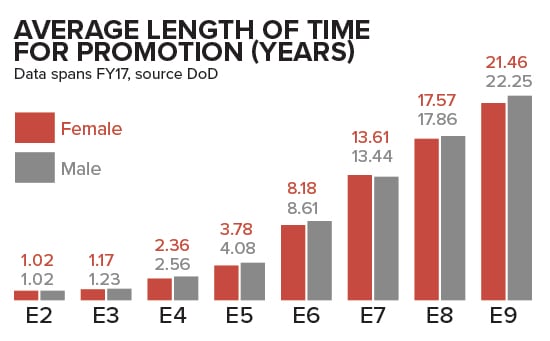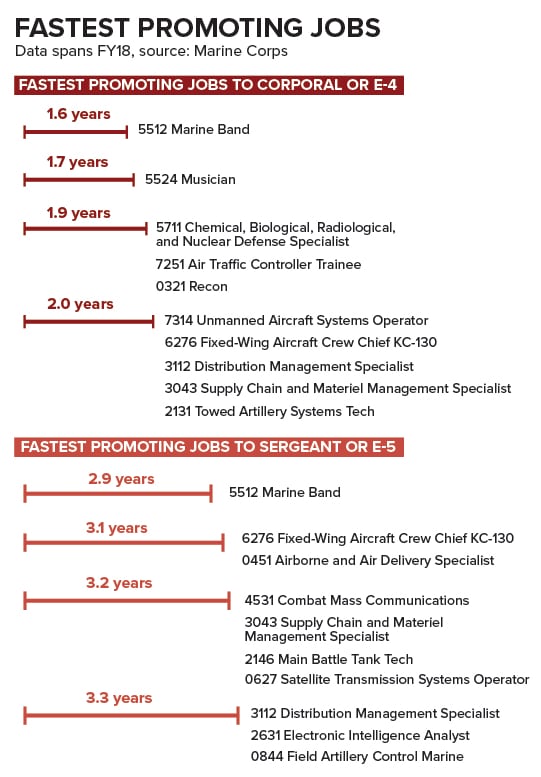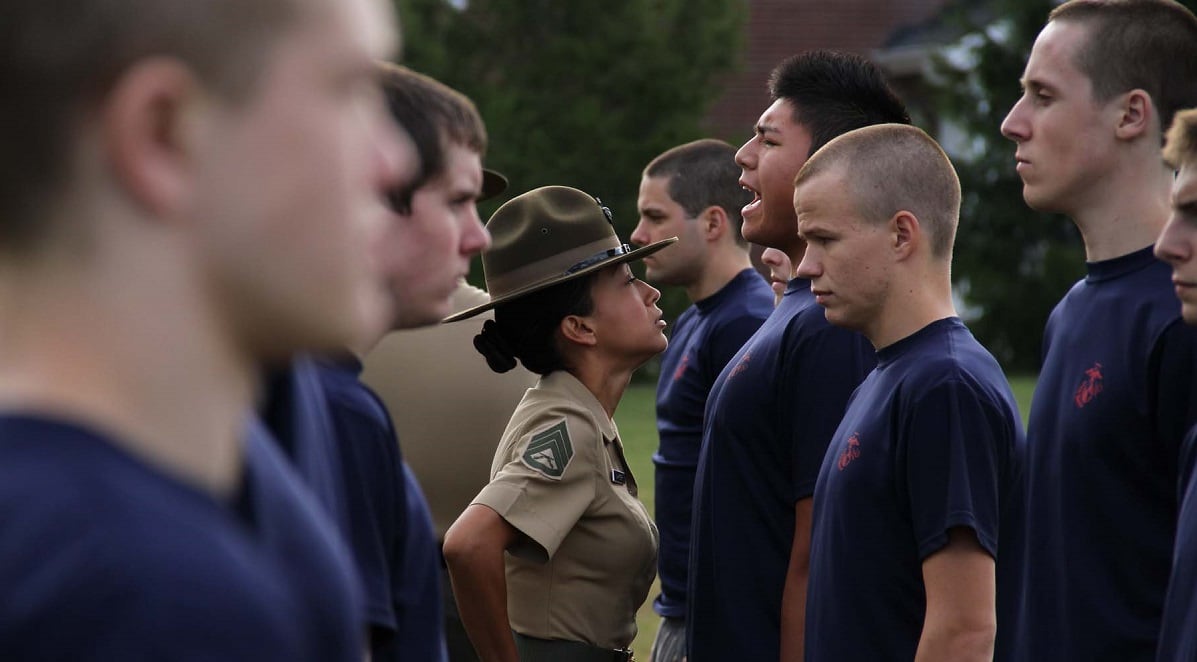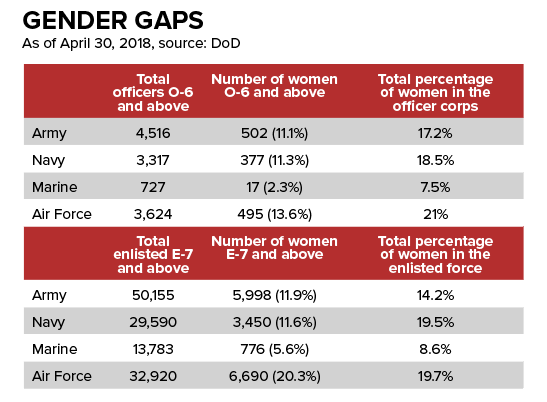Female enlisted Marines are promoting at faster rates than men — on average picking up E-6 almost a half year more quickly than male Marines, Defense Department data shows.
The unexpected trend is unique to the Marine Corps; a Military Times analysis of forcewide promotion data from 2016 and 2017 shows no similar gap among soldiers, sailors or airmen.
The surprising numbers indicate that the trend may start early in a Marine’s career and persists nearly until retirement.
The gender promotion gap is evident from the E-3 ranks all the way to E-6 with a dip at E-7, the only rank males pick up quicker. The gap is seen again at the E-8 rank. At E-9, the small cadre of women among the senior enlisted ranks are getting promoted nearly a year earlier than their male peers.
RELATED

The rapid advancement of women is unlikely a result of bias in favor of female Marines because the Corps’ promotion system advances Marines automatically based on cutting scores and other factors through the rank of E-5. Only at the rank of E-6 and above are promotions decided by a board of other Marines who review files and make discretionary decisions about who makes rank and who does not.
So why are women moving up the career ladder faster than men?
It may be in part because female Marines start out has higher quality recruits. The Corps has very few women — only 8 percent of the force — and competition is intense for young women seeking to join.
Another potential explanation is that women may be drawn to career fields that tend to move up faster, skewing the average time to promotion in their favor.
Corps officials say gender has nothing to do with it.

“The Marine Corps does not recruit, assess, promote or retain based on gender, race, religion, creed or color; therefore, gender is not factored into promotion planning process and we are not able to offer any insight concerning the differences in promotion timing between men and women,” Yvonne Carlock, a spokeswoman for Manpower and Reserve Affairs, told Marine Corps Times.
Retired Navy Capt. Lory Manning, head of government relations for the Service Women’s Action Network, an advocacy group for female service members, told Marine Corps Times that the root of the trend starts before boot camp.
“It is harder for women to get into the Corps,” Manning said.
“You’re probably getting a higher quality” female recruit in the Marines, Manning said.
The former commander of the only female recruit training battalion aboard Parris Island, South Carolina, retired Lt. Col. Kate Germano, echoed some of those sentiments.
“I know more women come into the Marine Corps with 15 college credits since the Marine Corps recruits women differently than men. That means they are promoted to PFC out of boot camp at an accelerated pace, which I would imagine, then translates into a continuing pattern throughout their careers,” Germano said.
Marines can pick up rank after graduating boot camp if they enlisted with college credit.
Germano recently authored the book “Fight Like a Girl,” which details problems and inequalities surrounding the training of female Marines at the recruit depot.
The other factor may be there are very few women in the infantry, which has traditionally been a slow-moving career field. For example, roughly only 100 women are serving in combat job fields that were previously excluded women.
In fiscal year 2017, the average infantry Marine in the 0311 military occupational specialty took nearly six years on average to promote to E-5 or sergeant.

On the other hand, one of the top promoting fields for sergeants that year was admin and supply, taking four years for a basic admin person and under five years for Supply Administration and Operations Specialist and a Contract Specialist to pick up the same rank.
Nearly 670 women made up those administrative fields in FY 2017.
Another fast promoting track is communications and data communications. In fiscal 2017, it took just over four years on average for these individuals to pick up sergeant and over 800 women hailed from these career fields.
Data peeps, the Marines that keep your classified and unclassified internet connections humming, picked up sergeant in about 4.28 years. Just over 170 women in 2017 comprised this career field.
It’s also worth noting that the Corps’ promotion stats may also be affected by the low number of women serving in the Corps.
In total, the Corps is just above 8 percent female, though the Commandant, Gen. Robert B. Neller, has often said he’d like the Corps to grow to that figure to 10 percent over the coming years.
That small number would make the averages easy to sway by a few highly successful women.

“So just a few extra female promotions, and by extra I mean it doesn’t take as much to raise the percentage of enlisted women being promoted from E3 to E4,” Manning said. “Ninety two percent of the people competing for promotions are men, so it takes a lot more male promotions to raise things.”
Military Times obtained promotion data for more than 900,000 enlisted service members across the four military services who were serving in fiscal year 2016 and 2017. The analysis looked at the time in service for the troops who were promoted during that time period. Promotion data for officers was not included in the analysis.
NOT MANY FEMALE LEADERS
Women picking up rank quickly on the enlisted side is a welcome sign in the Corps, but some experts say the bigger concern is among Marines at the upper level of leadership.
There are far too few women holding billets in senior leadership positions, partly because there are so few female Marines in the career ranks and also because those positions are often filled with Marines from the combat arms career fields.
“I think that’s where the problem is,” Manning said.
Out of more than 13,700 Marines at the ranks of E-7 through E-9 across the Corps, only 776 are women. That means 94 percent of senior enlisted ranks in the Corps are held by men, according to Defense Department data as of April.
The number of women in senior enlisted roles across the Corps is “remarkably lower than the other services,” Manning said.
And the numbers get worst for senior officer billets in the Marine Corps.
As of April, the Defense Department only listed 16 female colonels in the Marine Corps and just one two-star general, meaning about 2.3 percent of ranks O-6 and above are held by women in the Corps.
It does appear that the Corps has been trying to remedy these low numbers, though.
Marine Maj. Gen. Loretta Reynolds, commander of Marine Corps Forces Cyber Command, was recently nominated for a third star and as deputy commandant for information. Reynolds is the first woman in nearly nine years for the Corps to be nominated for a third star.
The Corp’s last female three-star was Lt. Gen. Frances Wilson, who served until 2009.

And the Corps recently nominated Col. Lorna M. Mahlock, the deputy director of Operations, Plans, Policies and Operations Directorate, to pick up a star. She will also be the first black woman to pick up brigadier general in the Marine Corps.
“Over the past year the Marines are suddenly promoting more women to general,” Manning said. “I think someone noticed and they are trying to make that up right now.”
In an effort to draw more women into the Marine Corps, recruiting command has launched an aggressive marketing and advertising campaign aimed at recruiting more women.
“In support of our Marine recruiters and their efforts to meet accession requirements, we have developed several marketing strategies and initiatives to more effectively engage and spread our message of opportunity to all prospects, included women, and their influencers,” said James Edwards, a spokesman for Marine Corps Recruiting Command. “We have increased the amount of female-inclusive and female-specific marketing and advertising initiatives to generate awareness about what it means to be a Marine and to highlight opportunities for women in the Marine Corps.”
Those initiatives include removing gender-qualifying language, updating the Corps’ recruiting website and sending direct mail to female high school juniors and seniors. Now, more than 30 percent of the Corps’ direct mail goes to female high school juniors and seniors.
In 2017, the Corps released “Battle Up,” the first Marine advertisement prominently featuring a female protagonist, Edwards said.
“These commercials feature women in a more authentic and representative manner alongside their male counterparts and clearly communicates who we are as Marines, what we do in support of our nation’s interests, and why it should be important and aspirational to our country’s citizens,” he said.
But to hit the 10 percent goal, the Corps will need to ship approximately 3,400 women to recruit training annually, according to Edwards.
Shawn Snow is the senior reporter for Marine Corps Times and a Marine Corps veteran.




